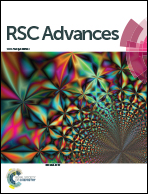Na9Sb(Ge2Q6)2 (Q = S, Se): two new antimony(iii) quaternary chalcogenides with ethane-like [Ge2Q6]6− ligands†
Abstract
Two new antimony(III) quaternary chalcogenides, Na9Sb(Ge2S6)2 and Na9Sb(Ge2Se6)2, were successfully synthesized in vacuum-sealed silica tubes. They crystallize in different space groups: C2/m for Na9Sb(Ge2S6)2 and C2/c for Na9Sb(Ge2Se6)2. In comparison with their structures, similar ethane-like [Ge2Q6]6− ligands and infinite [(Na/Sb)Q4]n chains exist in both of them, but note that two interesting [Na2Sb2(Ge2S6)2]8− and [NaS6] layers are discovered in the structure of Na9Sb(Ge2S6)2, rather than a 3D framework structure for Na9Sb(Ge2Se6)2. Moreover, overall investigation of the quaternary chalcogenides containing M–M bonds (M = Si, Ge) indicates that the orientation of the M–M bonds has a close relation with the number ratio of sodium/another cation and cation radius in the crystal structure, which may provide a feasible way to predict the orientations of the M–M bonds in the layers for new compounds. The UV-vis-NIR diffuse reflectance and IR spectra of Na9Sb(Ge2S6)2 are measured and show that it can be expected to be a promising IR optical window material with a wide IR transmission range from 0.48–22 μm. Raman spectra further verify the IR absorption edges and the presence of Ge–Ge bonds for the title compounds.
![Graphical abstract: Na9Sb(Ge2Q6)2 (Q = S, Se): two new antimony(iii) quaternary chalcogenides with ethane-like [Ge2Q6]6− ligands](/en/Image/Get?imageInfo.ImageType=GA&imageInfo.ImageIdentifier.ManuscriptID=C6RA22000B&imageInfo.ImageIdentifier.Year=2016)

 Please wait while we load your content...
Please wait while we load your content...